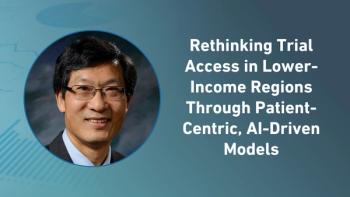
- Applied Clinical Trials-12-01-2020
- Volume 29
- Issue 12
Importance of Diversity in Parkinson’s Research
Eliminating barriers to engage underrepresented populations.
The Michael J. Fox Foundation for Parkinson’s Research (MJFF) aims to speed clinical research by removing obstacles that stand in the way of drug development. In pursuit of this mission, the Foundation gathers insights from a wide range of stakeholders and uses these perspectives to enhance clinical trial processes from start to finish. In Applied Clinical Trials’ Eye on Patient Advocacy series, we will share best practices and lessons learned from the field of Parkinson’s research that can be applied to clinical trials across disease states. In our latest column in this series, we explore the importance of addressing barriers to participation for historically underrepresented and marginalized groups.
Background
Despite growing emphasis on increasing diversity in clinical research, the proportion of underrepresented groups (URGs; defined in this study as women and gender minorities, racial and ethnic minorities, individuals earning below a median household income of $57,000, a high-school education or less, and/or rural residents) in Parkinson’s disease (PD) research remains low, with as many as 91% of participants identifying as non-Hispanic Caucasian in various studies.1–3 Although some studies, such as the MJFF online PD research platform Fox Insight (FI), have been designed to reduce or eliminate research barriers for URGs, equitable representation in PD research remains elusive.4 Without diverse inclusion in these trials, estimates of PD disparities in underrepresented populations, which remain poorly understood, may widen.5–7
Although the barriers to PD clinical research among underrepresented populations have been well identified, it remains unclear whether suggested interventions from the existing literature will improve engagement of traditionally underrepresented populations in PD research. For these reasons, MJFF sponsored the Fostering Inclusivity in Research Engagement for Underrepresented Populations in Parkinson’s Disease (FIRE-UP PD) Study to 1) explore whether it is possible to identify best practices to engage URGs in PD clinical research, 2) to assess knowledge and attitudes toward clinical research designs, and 3) to increase participation of URGs to FI.
Study design
Method
A request for proposals (RFP) was released for academic medical centers within the Parkinson Study Group research network to participate in FIRE-UP PD. Sites were instructed to identify a specific URG or geographical region to focus on, a specific barrier to PD research participation experienced by this group as categorized by the Picillo PD research barrier framework8, and a specified intervention as categorized by the Picillo et al. framework. Eight participating sites were selected, and were paired based on their proposed interventions and randomly assigned to either intervention or control conditions. Sites in Chicago, Boston, Denver, and Southern Florida were assigned to the intervention condition and were given $45,500 to execute their proposed design, whereas a second site in Chicago, the rural northern Midwest, the greater Seattle metropolitan area, and San Francisco were given $10,000 to serve as passive controls, maintaining their current recruitment workflow. Interventions included developing educational tools and surveys to engage community health centers in PD diagnosis (Boston), partnerships with local PD support groups to discuss PD research (Southern Florida), developing multi-stakeholder alliances and focus groups to create community-specific educational toolkits (Chicago), and recruiting community stakeholders to reimagine medical and research information for the community through a collaborative method called Boot Camp Translation (Denver).
The study was divided into three temporal phases for all sites: pre-intervention, to establish a recruitment baseline; intervention, to deliver a specified intervention or in the case of control sites, to continue passive recruitment activities, and post-intervention, to determine change from baseline. In addition to recruitment measures to FI, the FIRE-UP PD study was designed to collect survey responses from participants with regard to awareness and trust of PD research. Sites collected the Trust in Medical Research Scale (TIMRS), the Patient Engagement in Research Scale (PEIRS) and PD Research Participation Surveys, which assessed specific PD research designs and their impact on participation willingness. All sites also collected barriers to PD research participation, capturing reasons why URG individuals, who would otherwise participate in FIRE-UP PD, could not do so. All sites displayed FI recruitment materials as designed by MJFF and had a dedicated tablet device for FIRE-UP PD surveys and FI registration.
Results
The FIRE-UP PD study enrolled 488 individuals across the eight sites (intervention n=295), while 230 individuals (intervention barrier n=101) faced insurmountable barriers to participation, outlined in Figure 1 below.
Changes in trust, measured via TIMRS did not significantly improve for intervention sites relative to control sites, although a trend towards improvement emerged, t(382)=1.80, p=.073.There was no disproportionate change in patient engagement or in overall research participation willingness for intervention relative to control, all ts < 1. However, participant characteristics indicated that intervention site participants were significantly more diverse at both pre- and post-intervention with respect to race, ethnicity, income, and educational attainment.
Diverse accrual to FI (n=181) improved across all sites over the study period relative to sites’ own baselines, although intervention sites significantly improved diversity with respect to race, ethnicity, income, and educational attainment, while control sites improved race and ethnic diversity alone, as seen in Figure 2 below.
Conclusion
The FIRE-UP PD study was designed to measure barriers, attitudes, and FI accrual for URG populations accessing PD clinical research. The study suggests that URG recruitment could have increased by as much as 50% if common participation barriers such as language, time, and the digital divide were addressed. Although sampling and selection factors obscured trends in the attitudinal surveys, intervention sites recruited a broadly diverse sample of participants to complete surveys as well as enroll in FI, despite intervention sites’ focus on a single URG. Notably, although control sites were instructed to continue their baseline recruitment activities, nevertheless these sites yielded increased racial and ethnic diversity in FI. This suggests that while targeted interventions may yield substantial benefits to improved diversity of PD research participation, merely orienting to the problem of lack of study representativeness may alter even passive recruitment practices in subtle ways to promote more inclusive research participant cohorts. Developing detailed recruitment protocols that focus on particular URG populations as well as barriers faced by these groups may be a promising addition to PD research, although future studies will need to better understand specific mechanisms of efficacy and comparative effectiveness given similar site and study characteristics.
References
- Schneider MG, Swearingen CJ, Shulman LM, Ye J, Baumgarten M, Tilley BC. Minority enrollment in Parkinson’s disease clinical trials. Parkinsonism Relat Disord. 2009;15(4):258-262. doi:10.1016/j.parkreldis.2008.06.005
- Mainous AG, Smith DW, Geesey ME, Tilley BC. Factors influencing physician referrals of patients to clinical trials. J Natl Med Assoc. 2008;100(11):1298-1303. doi:10.1016/S0027-9684(15)31508-X
- Eskandar EN, Flaherty A, Cosgrove GR, Shinobu LA, Barker FG. Surgery for Parkinson disease in the United States, 1996 to 2000: practice patterns, short-term outcomes, and hospital charges in a nationwide sample. J Neurosurg. 2003;99(5):863-871. doi:10.3171/jns.2003.99.5.0863
- Jang M, Vorderstrasse A. Socioeconomic status and racial or ethnic differences in participation:web-based survey. J Med Internet Res. 2019. doi:10.2196/11865
- Svenson LW. Regional disparities in the annual prevalence rates of Parkinson’s disease in Canada. Neuroepidemiology. 1991;10(4):205-210. doi:10.1159/000110271
- Winter AC, Rist PM, Buring JE, Kurth T. Prospective comorbidity-matched study of Parkinson’s disease and risk of mortality among women. BMJ Open. 2016;6(9). doi:10.1136/bmjopen-2016-011888
- Chan AK, McGovern RA, Brown LT, et al. Disparities in Access to Deep Brain Stimulation Surgery for Parkinson Disease. JAMA Neurol. 2014;71(3):291. doi:10.1001/jamaneurol.2013.5798
- Picillo M, Kou N, Barone P, Fasano A. Recruitment strategies and patient selection in clinical trials for Parkinson’s disease: Going viral and keeping science and ethics at the highest standards. Park Relat Disord. 2015;21:1041-1048. doi:10.1016/j.parkreldis.2015.07.018
Authors of this report: Jonathan Jackson, PhD, Angie Sanchez, MD, Juliana Ison, and Helen Hemley, all with CARE Research Center-Massachusetts General Hospital; and Bernadette Siddiqi, MJFF
MJFF and Dr. Jackson would like to acknowledge the following individuals for their contribution to the research presented in this case study: Dr. Michael Schwarzchild (Co-I), Dr. Angie Sanchez (Research Fellow), Ms. Helen Hemley (Project Manager), and the site principal investigators: Dr. Mitra Afshari, Dr. Pinky Agarwal, Dr. Michael Aminoff, Dr. Meagan Bailey, Dr. Katelyn Bird, Dr. Stephanie Bissonnette, Dr. Michelle Fullard, Dr. Tarannum Khan, Dr. Danielle Larson, Catherine Wielinski, MPH, and Karen Williams, MS.
The MJFF Research Engagement Team includes James Gibaldi, MS, Associate Director; Tara Hastings, Senior Associate Director;Catherine M. Kopil, PhD, Director; Bernadette Siddiqi, MA, Associate Director; and Michelle Whitham, Research Partnerships Officer at The Michael J. Fox Foundation in New York, NY. To contact the MJFF Research Engagement Team email:
Past Columns in Series
The Importance of Site Selection
The Systemic Synuclein Sampling Study (S4) was a multicenter, cross-sectional, observational study sponsored by MJFF. The primary objective of this study was to better understand the progression of Parkinson’s disease (PD) by identifying the optimal biofluids and tissues for measuring the protein alpha-synuclein outside of the brain as a potential biomarker in individuals with PD. The secondary objective of the study was to create standard operating procedures for the collection and assessment of multiple tissues and biofluids to better understand alpha-synuclein’s potential as a biomarker for PD.
Overcoming Transportation Barriers
In January 2017, MJFF launched a survey to assess the need for transportation infrastructure at clinical trial sites. Data from the survey was used to inform the design of a transportation intervention that was tested via the Parkinson’s Disease Trial Recruitment Innovation (PD-TRI) project, an MJFF-funded pilot study aimed at reducing barriers and enhancing facilitators to clinical trial recruitment.
Retention Strategies: A Case Study
Patient retention is an important element of the Parkinson’s Progression Markers Initiative (PPMI), a landmark, longitudinal, observational study sponsored by MJFF. PPMI aims to find reliable and consistent biomarkers for PD progression by studying cohorts of Parkinson’s patients, populations at risk for PD, and controls without PD.
Building a Physician Referral Network: A Case Study
General practitioners often are not involved in the recruitment strategy for clinical trials. Historical barriers have made engagement with physicians challenging. They may fear losing care of patients to clinical trial site providers, be unfamiliar with the trial and principal investigator (PI), or have concerns about jeopardizing the doctor-patient relationship. One approach to building trust and overcoming these obstacles is for research institutions and PIs to actively engage with community physicians.
Articles in this issue
almost 5 years ago
E6 (R3) on Horizonalmost 5 years ago
Industry Forced to Rethink Patient Participation in Trialsalmost 5 years ago
Top 5 Global Clinical Trial Disclosure Changes in 2020 Amidst Pandemicalmost 5 years ago
Managing Risks in Clinical Trials During a Pandemic with ICH E6 (R2)almost 5 years ago
Applied Clinical Trials, December 2020 Issue (PDF)almost 5 years ago
Regulatory Data: How Technology Can Help ClinOps Survivealmost 5 years ago
Decentralized Trials, Pros and Consalmost 5 years ago
Public Trust and the ‘Last Mile’ for COVID-19 Vaccinesalmost 5 years ago
The Ever-Changing Face of NICE Guidance on Drug InnovationNewsletter
Stay current in clinical research with Applied Clinical Trials, providing expert insights, regulatory updates, and practical strategies for successful clinical trial design and execution.






.png)



.png)



.png)
.png)
